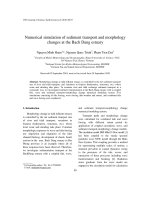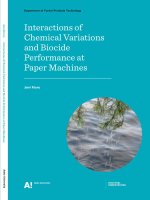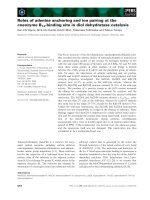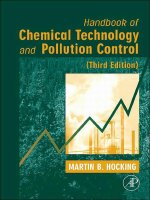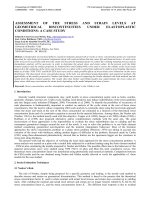Interactions of Chemical Variations and Biocide Performance at Paper Machines potx
Bạn đang xem bản rút gọn của tài liệu. Xem và tải ngay bản đầy đủ của tài liệu tại đây (4.39 MB, 128 trang )
9HSTFMG*aeefef+
ISBN 978-952-60-4454-5
ISBN 978-952-60-4455-2 (pdf)
ISSN-L 1799-4934
ISSN 1799-4934
ISSN 1799-4942 (pdf)
Aalto University
School of Chemical Technology
Department of Forest Products Technology
www.aalto.fi
BUSINESS +
ECONOMY
ART +
DESIGN +
ARCHITECTURE
SCIENCE +
TECHNOLOGY
CROSSOVER
DOCTORAL
DISSERTATIONS
Aalto-DD 148/2011
Jani Kiuru Interactions of Chemical Variations and Biocide Performance at Paper Machines
Aalto University
Department of Forest Products Technology
Interactions of
Chemical Variations
and Biocide
Performance at
Paper Machines
Jani Kiuru
DOCTORAL
DISSERTATIONS
Aalto University publication series
DOCTORAL DISSERTATIONS 148/2011
Interactions of Chemical Variations
and Biocide Performance at Paper
Machines
Jani Kiuru
Doctoral dissertation for the degree of Doctor of Science in
Technology to be presented with due permission of the School of
Chemical Technology for public examination and debate in
Auditorium Puu2 at the Aalto University School of Chemical
Technology (Espoo, Finland) on the 20th of January 2012 at 12
noon.
Aalto University
School of Chemical Technology
Department of Forest Products Technology
Supervisor
Professor Tapani Vuorinen
Instructor
Dr. Rolf Wathén
Preliminary examiners
Professor Martin A. Hubbe, North Carolina State University, USA
Professor Mika Sillanpää, Lappeenranta University of Technology
Opponent
Professor Angeles Blanco, Complutense University of Madrid, Spain
Aalto University publication series
DOCTORAL DISSERTATIONS 148/2011
© Jani Kiuru
ISBN 978-952-60-4454-5 (printed)
ISBN 978-952-60-4455-2 (pdf)
ISSN-L 1799-4934
ISSN 1799-4934 (printed)
ISSN 1799-4942 (pdf)
Unigrafia Oy
Helsinki 2011
Finland
The dissertation can be read at
Abstract
Aalto University, P.O. Box 11000, FI-00076 Aalto www.aalto.fi
Author
Jani Kiuru
Name of the doctoral dissertation
Interactions of Chemical Variations and Biocide Performance at Paper Machines
Publisher
School of Chemical Technology
Unit
Department of Forest Products Technology
Series
Aalto University publication series DOCTORAL DISSERTATIONS 148/2011
Field of research
Forest Products Chemistry
Manuscript submitted
5 September 2011
Manuscript revised
31 October 2011
Date of the defence
20 January 2012
Language
English
Monograph
Article dissertation (summary + original articles)
Abstract
The objective of this thesis was to study the interactions of microbial activity, biocide usage
and creation, and chemical changes in the papermaking process. The main focus was on
oxidative biocide systems. In addition, new measurement and biocide production methods
were applied to papermaking, and evaluated for the monitoring and control of the
microbiological state and biocide usage. The measurement methods were based on portable
handheld online equipments whereas the biocide production was based on electrochemical
generation of biocides.
The trials were mainly performed in pilot scale with actual process samples and
complemented with a few laboratory trials. Most of the pilot results were verified in several
field studies at paper machines. In the studies also the applicability of monitoring tools were
evaluated.
Biocide dosing itself, paper machine breaks, and poor management of broke generated
chemical variations, which were detrimental to the papermaking process. Spoilage of broke
due to poor broke management and poor biocide performance decreased the system pH,
increased the conductivity, and caused the defects to the web. These chemical variations were
also observed to cause variations in the cationic demand values. This probably caused
unwanted particle flocculation generating the spots and holes to the web. Base paper defects
were observed to cause runnability problems also at the coating machine. This cyclicity, where
chemical variations cause breaks and breaks cause chemical variations, should be eliminated
in order to restore good runnability.
When revealing many such cause-effect relations and hidden phenomena, hand-held
instrumentation gives additional references for existing basic measurements such as pH,
conductivity, and redox potential. This work also took in use measurements which have not
been traditionally used in papermaking such as measurement of halogens, dissolved calcium,
and dissolved oxygen contents. ATP content measurement using a portable luminometer was
found to be useful and easy-to-use method for evaluating microbial activity and optimizing
biocide performance at paper mills.
This thesis introduces a new biocide concept which can be used to prevent both microbial
and biocidal problems described above. The results demonstrate how electrochemical on-site
production can decrease chemical variations and improve biocide performance compared to
current best practices offering an efficient and economically attractive alternative for
microbial control.
Keywords
Papermaking, wet end chemistry, variation, oxidizing biocide, microbial control,
electrochemical treatment, online measurement, runnability, web break
ISBN (printed)
978-952-60-4454-5
ISBN (pdf)
978-952-60-4455-2
ISSN-L
1799-4934
ISSN (printed)
1799-4934
ISSN (pdf)
1799-4942
Location of publisher
Espoo
Location of printing
Helsinki
Year
2011
Pages
124
The dissertation can be read at
.fi/Diss/
Tiivistelmä
Aalto-yliopisto, PL 11000, 00076 Aalto www.aalto.fi
Tekijä
Jani Kiuru
Väitöskirjan nimi
Kemiallisten vaihteluiden ja biosiditehokkuuden väliset vuorovaikutukset paperikoneilla
Julkaisija
Kemian tekniikan korkeakoulu
Yksikkö
Puunjalostustekniikan laitos
Sarja
Aalto University publication series DOCTORAL DISSERTATIONS 148/2011
Tutkimusala
Puunjalostuksen kemia
Käsikirjoituksen pvm
05.09.2011
Korjatun käsikirjoituksen pvm
31.10.2011
Väitöspäivä
20.01.2012
Kieli
Englanti
Monografia
Yhdistelmäväitöskirja (yhteenveto-osa + erillisartikkelit)
Tiivistelmä
Tämän työn tavoitteena oli tutkia mikrobiologisen aktiivisuuden, biosidien käytön ja
valmistuksen sekä kemiallisten vaihteluiden välisiä vuorovaikutuksia paperinvalmistuksessa.
Pääasiallisesti työssä keskityttiin hapettaviin biosidijärjestelmiin. Lisäksi uusia mittaus ja
biosidin valmistusmenetelmiä sovellettiin paperinvalmistusprosessiin, sekä arvioitiin näitä
menetelmiä mikrobiologisen tilan ja biosidiannostelun mittaamiseen ja hallintaan.
Mittausmenetelmät perustuivat kannettaviin online-laitteisiin ja biosidien valmistus
sähkökemialliseen tuotantoon.
Kokeet tehtiin pääosin pilot-mittakaavassa oikeita prosessinäytteitä käyttäen. Tuloksia
täydennettiin muutamilla laboratoriokokeilla. Suurin osa pilot-kokeiden tuloksista
todennettiin kenttäkokeilla paperikoneilla. Näissä kokeissa arvioitiin myös
mittausmenetelmien käytettävyyttä.
Biosidin annostelu, katkot paperikoneella ja heikko hylyn käsittelyn hallinta aiheuttivat
kemiallisia vaihteluita, jotka olivat haitallisia paperinvalmistusprosessille. Heikosta hylyn
hallinnasta ja heikosta biosiditehokkuudesta johtunut hylyn pilaantuminen laski prosessin
pH:ta, nosti johtokykyä ja aiheutti vikoja rataan. Kemiallisten vaihteluiden havaittiin myös
aiheuttavan vaihteluita prosessin varaustilassa. Tämä todennäköisesti aiheutti ei-toivottua
partikkeleiden flokkautumista aiheuttaen edelleen reikiä ja täpliä rataan. Pohjapaperin
vikojen havaittiin aiheuttavan ongelmia myös päällystyskoneella. Em. syklisyys, jossa
kemialliset vaihtelut aiheuttavat katkoja ja katkot aiheuttavat kemiallisia vaihteluita, pitäisi
pystyä pysäyttämään hyvän ajettavuuden palauttamiseksi.
Osoitettaessa em. syy-seuraus suhteita ja piileviä ilmiöitä, kädessä pidettävät laitteet antavat
lisäreferenssejä nykyisille perusmittauksille kuten pH, johtokyky ja redox potentiaali. Tässä
työssä otettiin myös käyttöön mittauksia, kuten liuennut kalsium ja happi sekä halogeenit,
joita ei yleisesti ole paperinvalmistuksessa käytetty. ATP pitoisuuden mittaus kannettavalla
luminometrillä havaittiin olevan hyödyllinen ja helppokäyttöinen menetelmä mikrobiologisen
aktiivisuuden arviointiin ja biosiditehokkuuden optimointiin paperitehtailla.
Tämä väitöskirja esittelee uuden biosidikonseptin, jota voidaan käyttää yllä mainittujen
mikrobiologisten ja biosidilähtöisten ongelmien ehkäisyissä. Tulokset demonstroivat kuinka
biosidien sähkökemiallisella on-site tuotannolla voidaan vähentää kemiallisia vaihteluita ja
parantaa biosiditehokkuutta verrattuna nykyisiin menetelmiin. Sähkökemiallinen biosidien
valmistus paikan päällä tehtaalla tarjoaa tehokkaan ja taloudellisesti kiinnostavan
vaihtoehdon mikrobien hallintaan.
Avainsanat
Paperinvalmistus, märkäosan kemia, vaihtelu, hapettava biosidi, mikrobien
hallinta, sähkökemiallinen käsittely, online mittaus, ajettavuus, ratakatko
ISBN (painettu)
978-952-60-4454-5
ISBN (pdf)
978-952-60-4455-2
ISSN-L
1799-4934
ISSN (painettu)
1799-4934
ISSN (pdf)
1799-4942
Julkaisupaikka
Espoo
Painopaikka
Helsinki
Vuosi
2011
Sivumäärä
124
Luettavissa verkossa osoitteessa
.fi/Diss/
7
CONTENTS
ABSTRACT 3
TIIV ISTELMÄ 5
CONTENTS 7
LIST OF ORIGINAL PUBLICATIONS 9
THE AUTHOR’S CONTRIBUTION 10
ABBREVIATIONS 11
1. INTRODU CTION 13
2. THE OBJECTIVE AND THE OUTLINE OF THE STUDY 16
3. PAPER MACHINE AS ECOSYSTEM 17
3.1 Water systems at paper mills 17
3.2 Paper machine runnability 19
3.3 Detrimental substances in neutral papermaking 22
3.4 Chemicals and chemical interactions 23
3.5 Monitoring of process chemistry 25
4. MICROBES IN PAPERMAKING 33
4.1 Different types of microbes at paper machines 33
4.2 Formation of biofilm 34
4.3 Microbial problems in papermaking 35
4.4 Measurements of microbial activity 36
5. PREVENTION OF MICROBIAL GROWTH 40
5.1 Biocides 41
5.2 Good housekeeping 49
5.3 Boilouts 50
5.4 Alternative treatments 50
6. BIOCIDE EFFICIENCY AND PAPER MACHINE CHEMISTRY
INTERACTIONS 51
6.1 Corrosion 52
6.2 Interference with additives and process chemistry 53
8
EXPERIMENTAL PART 57
7. MATERIALS AND METHODS 57
RESULTS AND DISCUSSION 70
8. GROWTH OF BACTERIA IN PAPERMAKING PROCESS
(Papers I and V) 70
8.1 Development of anaerobic conditions 70
8.2 Pulp deterioration and wet end chemistry 71
8.3 Spoilage and end product quality 76
9. REVEALING HIDDEN PROCESS PHENOMENA WITH
PORTABLE INSTRUMENTS (Papers III and IV) 77
9.1 Analysis of microbial activity 78
9.2 Measurement of biocide residues 79
9.3 Optimization of biocide dosage 82
9.4 Measurement of other chemical parameters 84
10. INFLUENCE OF BIOCIDES AND BIOCIDE INTERACTIONS
ON PAPERMAKING PERFORMANCE (Papers III and V) 88
10.1 Chemical variations due to biocide addition 88
10.2 Effect of biocides on runnability and product quality 90
11. NEW CONCEPT FOR ELECTROCHEMICAL BIOCIDE
GENERATION (Papers I and II) 94
11.1 Generation process 94
11.2 Efficiency in papermaking 96
11.3 Dual biocide concept 102
12. CONCLUSIO NS 107
REFERENCES 111
9
LIST OF ORIGINAL PUBLICATIONS
This thesis is based on the following scientific articles, which are referred in
the text by their Roman numerals. In addition, some unpublished data are
presented.
I Kiuru J, Tukiainen P, and Tsitko I. (2010). Electrochemically
Generated Biocides for Controlling Contamination in Papermaking,
BioResources 5(4), 2664-2680.
II Kiuru J, Sievänen J, Tsitko I, Pajari H, and Tukiainen P. (2011). A
New Dual Biocide Concept for Fine Papermaking, BioResources
6(2), 2145-2160.
III Kiuru J, Peltosaari A, and Wathén R. (2011). Reviewing the
Potential of Hand-held Sensors as Performance Indicators for Wet
End Chemistry, Ipw 1/2011, 17-23.
IV Kiuru J, Tsitko I, Sievänen J, and Wathén R. (2010). Optimization
of Biocide Strategies on Fine Paper Machines, BioResources 5(2),
514-524.
V Kiuru J, and Karjalainen S. (2011). Influence of Chemical
Variations on Runnability of Paper Machines and Separate Coating
Lines, Ipw 10/2011, 11-17.
All content taken from the original publications are re-printed with
permission.
10
THE AUTHOR’S CONTRIBUTION
Publication I: Designed the experiments, interpreted the results, and
prepared the first draft of the manuscript.
Publication II: Designed the experiments and interpreted the results in
part, and prepared the first draft of the manuscript.
Publication III: Designed the experiments, performed the analysis,
interpreted the results, and prepared the first draft of the manuscript.
Publication IV: Designed the experiments, interpreted the results in part,
and prepared the first draft of the manuscript.
Publication V: Designed the experiments, interpreted the results, and
prepared the first draft of the manuscript.
11
ABBREVIATIONS
AKD Alkylketene dimer
AOX Adsorbable organic halogen compounds
ASA Alkenylsuccinic anhydride
ATP Adenosine triphosphate
BCDMH 1-bromo-3-chloro-5,5-dimethylhydantoin
BDC BioDeposit control
BOD Biological oxygen demand
CFU Colony-forming units
CMC Carboxymethyl cellulose
COD Chemical oxygen demand
CTMP Chemithermomechanical pulp
DBMH 3-dibromo-5,5-dimethylhydantoin
DCDMH 1,3-dichloro-5,5-dimethylhydantoin
DCS Dissolved and colloidal substances
DOC Dissolved organic carbon
EDXRF Energy dispersive x-ray fluorescence
EPA US environmental protection agency
EPS Exopolysaccharide
ISE Ion-selective electrode
MAF Electrochemical microbial antifouling
MAR Multivariate autoregressive
MPC Model predictive control
NA Nutrient agar
NSSC Neutral sulfite semichemical
OBA Optical brightening agent
PAA Peracetic acid
PCA Principal component analysis
PCM Paper coating machine
PID Proportional integral derivative
PM Paper machine
PMEU Portable microbial enrichment unit
RLU Relative light unit
12
ROS Reactive oxygen species
SPC Sodium percarbonate
TOC Total organic carbon
WES Wet end simulator
13
1. INTRODUCTION
Conditions in a papermaking process are often favorable for microbes to
grow (Kolari 2003). Microbes in the process can cause a multitude of
production problems, from decreased production efficiency via impaired
runnability and raw material spoilage to product safety issues (Edwards
1996; Ludensky 2003; Väisänen et al. 1998).
Because of their detrimental effect, microbes in the process are controlled
with biocides. They act either by killing microorganisms (biocidal effect) or
by inhibiting the growth of micro-organisms (biostatic effect). An ideal
biocide should meet several requirements such as (Edwards 1996):
x
Applicability over a wide range of operating conditions.
x
No interference with other additives.
x
Broad spectrum of activity towards microbes.
x
Efficient and fast-acting.
x
Environmentally friendly and non-toxic.
x
Safe for the operator.
x
Low-cost.
x
Easy-to-handle.
Unfortunately, there is no biocide that can encompass all the requirements,
and none of the biocides is suitable for all applications.
Annually, over 200 million Euros are spent on slime prevention by the
paper industry in Europe. The total sales of (non-oxidizing) slime
preventing chemicals (presented in Figure 1) has started to decrease after
the peak in 2003 (Finnish Environment institute 2007). Contrary to the
traditional biocides, in the last few years, the sales of oxidizing biocides
have radically increased (Kolari 2007). The increased interest directed
towards oxidizing biocides is due to their low cost. Oxidizing biocides also
degrade faster, and the degradation products are not harmful or toxic, but
environmentally sound. Typical biocide costs at paper machines vary
between 1 and 4 €/paper ton. For average sized fine paper machine this
means 0.5-1 million Euros in annual cost (Sievänen 2008).
14
Figure 1 The total sales (tons) of non-oxidizing slime preventing chemicals in Finland
(modified from Finnish Environment Institute 2007).
The development of a biocide strategy for a paper mill is always a
compromise between the costs and performance. An insufficient use of
biocides endangers the machine runnability and product quality (Blanco et
al. 1996; Ludensky 2003). On the other hand, extensive use of biocides is
not only expensive, but may result in unwanted interactions with the
process and other chemicals (Casini 2003; Simons and da Silva Santos
2005). Papermaking is a dynamic process in a continuous state of change.
Thus, evaluation of biocide performance is challenging. The results should
be available instantly for reliable evaluation. This is not possible with
traditional plating methods for determination of microbial counts. Indeed,
more efficient methods would be beneficial.
During the past years the biocide development has been rapid. Reductive
biocides were first replaced by strong oxidizers. After noticing the problems
with the strong oxidizers (Simons and da Silva Santos 2005) the
development has been towards weak oxidizers and stabilized halogens.
Both continuous and batch additions of these biocides have been used
(Schrijver ad Wirth 2007). During this development, in author’s knowledge,
in publically available literature basically no negative features of these
biocides have been reported. This is rather surprising since these oxidizers
15
are salts, they are dosed in certain pH, and they do interact with the process
and with other chemicals.
Biocide usage and microbial growth both can cause chemical variations in
papermaking processes. Interactions of biocides and chemical variations in
a papermaking process are not thoroughly investigated. Having a clear
understanding of the interactions would allow economically and
environmentally efficient use of the biocides.
From the biocide treatment point of view the measurements are required in
order to prevent errors in dosage. According to Hubschmid (2006) such
measurements should not only include detailed monitoring system of
biocide dosage but also:
x
The type and quantity of other chemicals used in the process should
be known, as well as physical data of the product to be treated such
as temperature range, pH, redox potential and so on.
x
Technical installations, such as agitator systems, re-circulation lines
have to be evaluated with respect to choosing dosage points.
x
It is important to determine the minimal inhibition concentration of
the biocide to be used.
In fact, process measurements, diagnostics, and automation are widely
being used in modern papermaking (Ruetz and Meitinger 1998). The mills
are reducing personnel, and thus more measurements and analysis need to
be performed automatically or quickly. On the other hand, more control
loops are built, and measurements need to be continuous to maintain the
control (Rantala et al. 1994; Artama and Nokelainen 1997; Bley 1998).
Traditionally, process monitoring has been a combination of inline and
online measurements and extensive laboratory work (Leiviskä 2000). These
traditional inline sensors are real-time measuring equipment, but collected
data is restricted due to the fixed sensor installation. Therefore, the
measurement matrix is rather fixed and difficult to adapt to process
changes, trial runs, etc. Having portable devices, which would be capable of
performing all these necessary functions would allow adaptive monitoring
and control. This would also meet the requirements for preventing errors in
demanding biocide dosing.
16
2. THE OBJECTIVE AND THE
OUTLINE OF THE STUDY
The objective of this work was to study the interactions of microbial
activity, biocide usage and - creation and chemical changes in the
papermaking process. Main focus was on oxidative biocide systems,
because these systems have widely taken over the biocide markets and the
interactions have not been studied adequately. Moreover the emphasis was
on neutral/alkaline papermaking. In addition, new measurement and
biocide production methods were applied to papermaking, and evaluated
for the monitoring and control of the microbiological state and biocide
usage. The methods were based on portable handheld online equipments.
The biocide production was based on electrochemical generation of
biocides, which enables on-site production of oxidative biocides.
Relevant scientific literature is reviewed in chapters 3-6. The review
presents an overview of chemistry and microbiology at paper machines. It
covers also the basics of prevention of microbial problems as well as
potential interactions with the process due to these prevention programs.
In the experimental part in the results and discussion, chapter 8
concentrates on illustrating the growth of bacteria in the process and
chapter 9 on measurement tools and philosophy to reveal the hidden
phenomena occurring in the process. Chapter 8 shows the effect of
microbial growth on paper machine chemistry and product quality, whereas
chapter 10 shows how biocide program can affect those. Field data
examples present the effect of biocides on runnability of paper machine as
well as on web performance in converting processes.
Chapter 11 introduces a new biocide concept which can be used to prevent
both microbial and biocidal problems described above. The chapter
demonstrates how electrochemical on-site production affect chemical
variations and biocide performance compared to current best practices.
Chapter 12 gives the overall conclusions and suggestions for further
research.
17
3. PAPER MACHINE AS ECOSYSTEM
“An ecosystem is a biological environment consisting of all the organisms
living in a particular area, as well as all the nonliving, physical components
of the environment with which the organisms interact”
( A good example of an industrial
ecosystem is a paper machine, specifically chemical and microbiological
phenomena and interactions occurring in the complex water circulations of
the machine. Chemical stability in the water circulations goes a long way in
establishing the whole efficiency of the paper machine process.
3.1 Water systems at paper mills
The papermaking process is basically a very large dehydration process.
Consistency of the stock flow entering the paper machine headbox is
typically 0.2%-1.0% (2-10g fiber per kg water). After drainage on the wire or
forming section the web consistency increases to 15%-25%. Mechanical
compression removes water on the press section. The web consistency
increases to 33%-55% depending on the paper grade and press section
design. After the press section, the web enters the dryer section where
evaporation removes the remaining water. A small amount of moisture
(5%-9%) remains in the paper even after the dryer section (Kuhasalo et al.
2000). In addition, in practice water leaves the paper mill also as
wastewater to the wastewater treatment plant, which means that even in
the most closed mill system, fresh water is needed to compensate this loss
of water. Figure 2 illustrates the water balance of a typical paper mill.
18
Figure 2 Paper mill’s water household (Weise et al. 2000).
Inside the paper mill the water is reused and cycled in several circulations.
The water removed in the wire part of the paper machine is discharged into
the wire pit. This water is used to dilute the stock fed to the paper machine.
The diluted stock is pumped via centricleaners, air removal equipment, and
screens to the headbox and ahead to the wire section. This system is called
short circulation (Weise et al. 2000).
A part of the water removed in the wire and press section that is not led
back into the headbox as described above, is utilized in the earlier stages of
19
the papermaking process. These waters compose a long circulation of the
paper machine. Water in the long circulation is used for example to adjust
the consistency and to improve the material and heat economy (Ryti 1983).
This water, which has been used at least once before is called white water
and, is also processed using various means.
With an optimized water usage modern paper machines can operate with
very low fresh water consumptions. Usually the degree of closure (fresh
water added to the process) varies between 2 and 20m
3
/t of produced paper
depending on process and water processing technologies used (Weise et al.
2000). Low water usages lead to accumulation of various substances into
water cycles. Especially the dissolved and colloidal fractions are difficult to
separate (Wearing et al. 1985; Kokko et al. 2004).
3.2 Paper machine runnability
The fastest paper machines have an average running speed of nearly
2000m/min. The maximum width of paper machines is approximately 11
meters (Going 2008). Since the width increase would be expensive and
difficult (vibration of the cylinders at high speeds), the production
efficiency improvements are carried out by decreasing the downtime
(breaks, web defects, broke volume) and increasing the production speed
(Kurki et al. 2000).
The increase in production speed of a paper machine is often limited by
increasing web breaks. In practice, reason (cause, location) behind web
breaks need to be identified before speed increase is possible. In a study by
Hokkanen (1996), the author showed that most of the web breaks occurred
just after the press section when the paper web is wet (dryness 40-60%)
(Figure 3).
20
Figure 3 The location of web breaks during a six months follow-up study at a magazine
paper machine in Finland (Hokkanen 1996).
Based on many published studies, web breaks can be explained by the high
tension or low strength of the paper web. The studies suggest that web
breaks are possible in the strength/tension range where these two
distributions overlap. In practice, this means that statistical variation in
tension and strength can cause the breaks (Wathén 2003; Wathén and
Niskanen 2006; Roisum 1990a; Korteoja et al. 1998). The importance of
minimizing periodical fluctuations of the process is therefore necessary for
good runnability. The studies also suggest that the defects and the amount,
size, shape, and position of the defects affect the break sensitivity (Wathén
2003; Uesaka 2005). The role of chemical stability and chemical variations
has been acknowledged as a key to undisturbed paper production (Haapala
et al. 2010; Hubbe et al. 2006; Sihvonen et al. 1998; Wathén 2007; Kallio
and Kekkonen 2005). Therefore, it can be expected that significant amount
of web defects have chemical background.
There can be numerous possible causes behind an individual machine
break. Even thou the cause fundamentally have physical, chemical or
microbial background (or combination of these), the actual brake can be
related to pitch deposition, various chemical deposits, stickies and other
adhesives in recycled paper processes and microbiological slime (Haapala
et al. 2010). In addition, paper holes and spots, cuts and sheet breaks have
been reportedly been cause by shives or flakes, bubbly gasses of droppings
from the paper machine onto the web (Roisum 1990b). Also breaks due to
21
mechanical problems, condensations droplets and many more have been
reported.
Closing of the water circuits of paper machines leads to a situation when the
amounts of dissolved and colloidal substances increase (Wearing et al.
1985; Kokko et al. 2004). These materials are derived from wood
constituents like lignin, hemicelluloses and extractives. Many additives
have effects on water properties as well. The studies have shown that
contaminants in white water decrease the strength of paper (see Figure 4).
Tay (2001) suggests that contaminants in white water make the fibrous
material more hydrophobic and hinder the formation of bonds. This is seen
as reduction in paper strength. Based on the important role of chemical
stability, the same phenomena can cause web defects and breaks at a paper
machine. Haapala et al. (2010) have shown that elevated conductivity,
charge, and dissolved calcium levels increased the formation of defects on
paper machine.
Figure 4 Relationship between surface tension and breaking length as a function of
contaminant additions (Tay 2001).
Chemical stability has widely been acknowledged as a key to undisturbed
and clean paper production. Production of chemical deposits has been
attributed for example to variations in the process pH, temperature and the
charge (Haapala et al. 2010; Hubbe et al. 2006; Sihvonen et al. 1998;
Wathén 2007; Kallio and Kekkonen 2005). The importance of stable
process is increased when water systems are closed, filler usage increased,
and the amount of different substances in the process and water cycles has
increased.
22
3.3 Detrimental substances in neutral papermaking
Substances detrimental in papermaking can enter the papermaking process
with the fresh water, with the raw materials (pulp, chemicals) or from the
machinery (Kanungo 2005). Although the factors such as water hardness
and microbes in the fresh water or dissolved and colloidal substances from
the wood can also directly cause problems, the difficulties are most often
faced in the white water systems when these components accumulate.
White water in papermaking is described as water that has been used at
least once before. It means that white water is never clean. It includes
substances from fresh water, stock preparation, dissolution occurred during
beating or pulp storage, additives, broke or microbiological activity.
Because of the closed water circulations and twin wire machines the
amount of detrimental substances have increased and caused problems in
the papermaking.
Water from the pulp is removed in successive stages of dewatering by free
drainage and other drainage elements in the wire section and is collected in
the wire pit, seal pit, storage tank, and silo. Water removed from the web in
the press section, along with shower water, is collected also trough the
vacuum elements. Water collected from each stage of dewatering contains
different proportions of fiber, filler, fines and other materials. These
materials in water can be divided in two categories: suspended solids and
dissolved and colloidal substances (Panchapakesan 1993).
Suspended solids are usually salts, fillers or fiber. High concentrations of
suspended solids are of concern in terms of deposits, lowered filtration of
the saveall, and plugging (Panchapakesan 1993).
Most detrimental substances are ionic dissolved and colloidal substances.
They can absorb or precipitate onto the surfaces of fibers, fillers, and fines,
which adversely affects fiber-to-fiber bonding, brightness, and the
accessibility of the process chemicals. Table I lists the composition of
dissolved and colloidal substances according to their origin.
23
Table I Composition and origin of dissolved and colloidal substances (Weise et al. 2000).
Chemical compound Origin
Sodium silicate Peroxide bleaching, deinking,
recovered paper
Polyphosphate Filler dispersing agent
Polyacrylate Filler dispersing agent
Organic acids Filler dispersing agent
Carboxymethyl cellulose Coated broke
Starch Recovered paper, broke,
strengthening agents
Humic acid Fresh water
Lignin derivates Kraft pulp, mechanical pulp
Lignosulfonates Sulfite and NSSC pulp, CTMP
Hemicelluloses Mechanical pulp
Fatty acids Mechanical pulp
Inorganic substances are mainly salts or cations and anions, of which those
salts are composed. Inorganic substances can affect the swelling of fiber.
They can also reduce fibers ability to bond. Organic substances include
pitch, carbohydrates and lignin. They all derive from the wood. Pitch
consists of fatty acids. Fatty acids are oxidized and polymerized to
macromolecular compounds, which can cause pitch deposits.
Carbohydrates and lignin can cause the raise of biological oxygen demand
(BOD), chemical oxygen demand (COD) and the amount of total organic
carbon (TOC). Deposits from latexes, ash and pitch from wood are called
white pitch (Sirén 1996).
3.4 Chemicals and chemical interactions
Natural fibers are a major source of chemically reactive components in
papermaking. Chemical additives are introduced into the pulp suspension
with a view to alter the properties of paper (functional chemicals) or to
improve the process (process chemicals). For these chemicals to perform
properly, they must be able to react with or adsorb on the fiber. The
mechanisms might differ considerably from case to case (Sten 2000).
A cellulosic fiber has a very hydrophilic surface, which chemically consists
of hydroxyl groups. On the surface of the fiber, there are also some carboxyl
groups. Due to its chemical composition and mechanical structure, the
surface of the fiber is easily transformed by beating into a two-dimensional
hydrocolloid of cellulose fibrils and microfibrils having a negative

